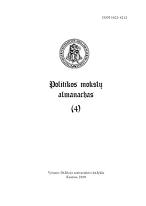Vamzdynų geopolitika Centrinės Azijos regione tarp Rusijos ir Vakarų
Pipeline Geopolitics in Central Asia Region between Russia and the West
Author(s): Giedrius ČesnakasSubject(s): Politics / Political Sciences
Published by: Vytauto Didžiojo Universitetas
Keywords: Vamzdynų geopolitika Centrinės Azijos regione tarp Rusijos ir Vakarų; Pipeline Geopolitics in Central Asia Region between Russia and the West
Summary/Abstract: After the collapse of Soviet Union in Central Asia geopolitical vacuum formed where the major powers of the world, including neighbors of republics of Central Asia, tried there to increase their influence. Interests in gaining influence in Central Asia were determined not only by common interest spheres of realism, as increasing geopolitical power or power restriction of possible rivals, but also aspects of neorealism like energy security and economical influence, which are even more important. In that way, pipelines of energetic resources are not only in sphere of economical interest, but also is the way of gaining geopolitical power. Russia, as the dominant power in Eurasian continent, tries to regain its lost impact on Central Asia after collapse of Soviet Union. After 1991 it started to plan the ways of expansion its economical and political power to Central Asia through development of oil and gas transportation pipelines which pass its territory. After gaining independence, republics of Central Asia didn’t have clear vision of their foreign policy, and their ties with Russia were still very strong and determined by common history and political culture, so Russia could do stronger impact on gaining beneficial pipelines routes, in that way eventually, strengthening its influence in world market of energy resources and also international politics. The President of Russian Federation Vladimir Putin greatly influenced Russian foreign politics based on energy resources and transportation routes, which helps Russia to regain influence in all other spheres. Western countries, and United States in the first place, acting on their own and through their partners, mainly Turkey, tied to gain greater influence in Central Asia through diversifying pipelines routes, and avoiding routes through Russian territory. In that way, European countries would become more independent from Russian energy politics in the region, and also Central Asia countries could maintain their preferred energy and foreign policy, avoiding Russian impact on they decisions. Countries with energy resources and without need using Russian transportation pipelines obviously strengthen their geopolitical positions as well as influence of Western counties, and become more independent from Russia. In such case there appears Azerbaijan, which becomes the main window of transportation of oil and natural gas of Central Asia to the world market, without any need passing Russia. For such economic and political projects United States donate and invest lots of money, for example “Baku–Supsa” or “Baku–Tbilisi–Ceychan” projects need billions of dollars, but investment repays not only in economic, but also in geopolitical profit – countries become part of Western cultural influence. In conclusion it is needless to say that Central Asia is now situated between two opposite vectors of influence Western and Russian, if not to bear in mind influence of China upon republics. In such tense situation the
Journal: Politikos mokslų almanachas
- Issue Year: 2008
- Issue No: 04
- Page Range: 39-56
- Page Count: 18
- Language: Lithuanian

